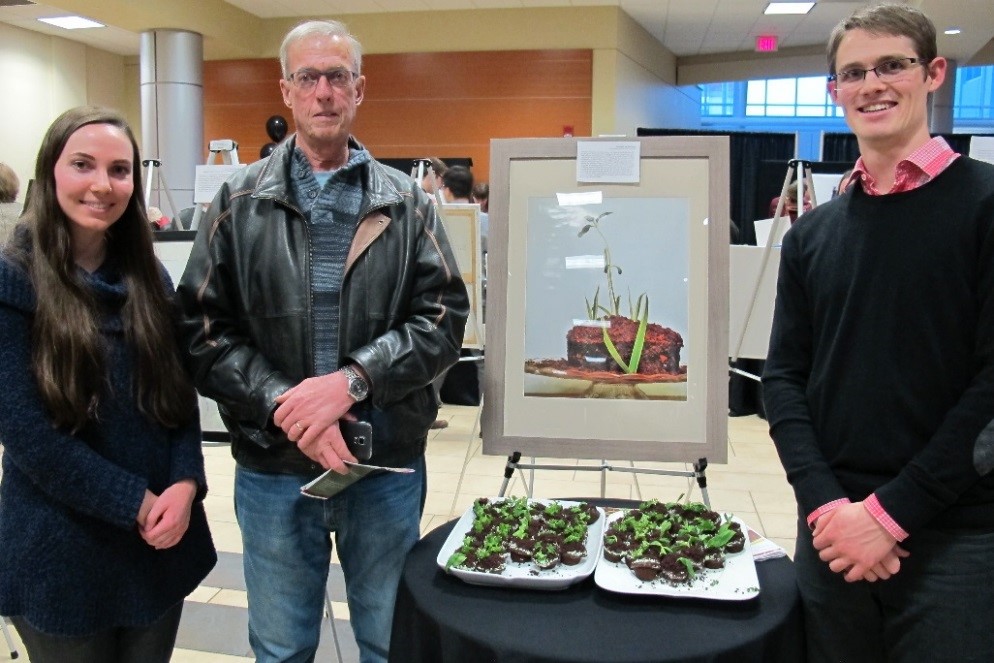Patient Immersion Experience: the other side of chronic illness
Laura Vega - 31 March 2016

Sarah Frehlich, Bill Card (patient mentor) and Micah Peters show their display “Growing hope: terminal illness to new life.”
Second-year medical students Micah Peters and Sarah Frehlich stood happily by their –edible– art project: chocolate cupcakes with plants seemingly growing out of them. Bill Card, their patient-mentor and inspiration for this display, was equally excited with the outcome.
Peters, Frehlich and Card were just a few of the participants in the Patient Immersion Experience (PIE), a two-year project of the Faculty of Medicine & Dentistry MD program’s physicianship course at the University of Alberta for new medical students. Through PIE, students are paired with patient-mentors living with chronic illnesses, looking to better understand what it means to be on “the other side” of the doctor-patient interaction and the struggles of a chronic health condition.The students’ time with the patient-mentors includes accompanying them to medical appointments and other activities from the patients’ daily life to get to know each other, and better understand their personal experiences within the healthcare system. The two years conclude with a creative art exhibit by the students, representing their insights and learning experience from the patient-mentor.
The artistic displays ranged from drawings and photo collages to interactive pieces, animations and even songs.
Micah and Sarah’s project, called “Growing Hope: terminal illness to new life” depicted their experience with Bill Card, who was diagnosed with scleroderma, a chronic condition that hardens the skin and connective tissue. “Initially in his diagnosis he was in the intensive care unit and had quite a poor prognosis.They told him he was going to die, but he proved them wrong and he was able to grow strong and recover. That’s why we say new life,” explains Frehlich. Peters adds: “It was powerful to see him in the lookout for a new perspective and doing more than just sitting around at home and moping.”
Inspiration from the patient-mentors’ resilience also struck student Carol Dennison, whose group was paired with Pam Corbett, a type 1 diabetes patient. “Pam is so inspiring because she’s always so happy and cheerful and she doesn’t let it change the way she lives her life,” says Dennison. “It taught me that people can have really happy fulfilling lives even when they’re sick.”
Dennison’s group created an installation with a dress, based on their patient-mentor’s story. “When we first met she told us how before she was diagnosed she was trying on a bridesmaid dress, and the person fitting her dress suggested that she might have diabetes because she was so thin.”
Corbett was pleasantly surprised with the art piece and the whole exhibit.
“I was absolutely blown away with what they did with our story and how it came through,” she says. “Little things I said that I didn’t even think were very important or very significant and they picked up on them for their project. Unbelievable.”
The Patient Immersion Experience project is a unique joint effort between the faculty’s MD and Arts & Humanities in Health & Medicine programs. The 161 students that presented their work this spring constitute the second group to complete PIE. Dr. Helly Goez, coordinator of the course, sees an outstanding value in the way this interaction allows future doctors to get an experience “without the white coat” and become sensitized to the patients’ needs as human beings. “All of us as physicians know that we have the patients that we carry in our heart that were mentors without even knowing it: they taught us about hope, about believing. They changed our lives in a way.”
The faculty’s goal is to engage a growing number of patients with chronic illnesses in contributing to the MD program and education of medical students.
Pam Corbett started as a volunteer for her family physician educating others about type 1 diabetes and the use of insulin pumps, and was later referred to the Faculty of Medicine & Dentistry and contacted about becoming a PIE mentor. She believes the program is a very important process for the students. “It gives them sort of a view of what it is like to be on the other side and how they can help in the way they speak to people, the way they react to people when they’re treating them, and maybe a list of what not to do,” says Corbett, laughing.
Bill Card started as volunteer for another faculty program, then continued into the Patient ImmersionExperience. “It’s always good to talk about it and give a different light on it to other people. It’s awesome and hopefully what I’ve done has helped them along the way.”
His students agree it certainly did.
* Most of the Patient Immersion Experience art projects will be on display for the general public at the John W. Scott Health Sciences Library until mid-April.